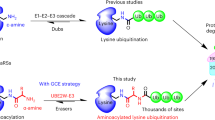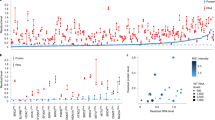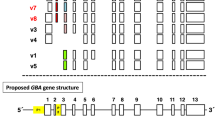Abstract
Modification of specific Ser and Thr residues of nucleocytoplasmic proteins with O-GlcNAc, catalyzed by O-GlcNAc transferase (OGT), is an abundant posttranslational event essential for proper animal development and is dysregulated in various diseases. Due to the rapid concurrent removal by the single O-GlcNAcase (OGA), precise functional dissection of site-specific O-GlcNAc modification in vivo is currently not possible without affecting the entire O-GlcNAc proteome. Exploiting the fortuitous promiscuity of OGT, we show that S-GlcNAc is a hydrolytically stable and accurate structural mimic of O-GlcNAc that can be encoded in mammalian systems with CRISPR–Cas9 in an otherwise unperturbed O-GlcNAcome. Using this approach, we target an elusive Ser 405 O-GlcNAc site on OGA, showing that this site-specific modification affects OGA stability.
This is a preview of subscription content, access via your institution
Access options
Access Nature and 54 other Nature Portfolio journals
Get Nature+, our best-value online-access subscription
$29.99 / 30 days
cancel any time
Subscribe to this journal
Receive 12 print issues and online access
$189.00 per year
only $15.75 per issue
Buy this article
- Purchase on Springer Link
- Instant access to full article PDF
Prices may be subject to local taxes which are calculated during checkout



Similar content being viewed by others
Data availability
Atomic coordinates and structure factors for the CpOGA–(S-GlcNAc peptide) complex structure are deposited in the Protein Data Bank under accession code PDB 6RHE. Source data for Figs. 1c, 2c and 3a–c and Extended Data Figs. 1b, 6 and 7 are available with the paper online. All other data are available upon reasonable request to the corresponding author.
Change history
30 April 2020
The following figures had source data links to the incorrect file: Fig. 2 was linked to the uncropped blot for Extended Data Fig. 2, Extended Data Fig. 2 was linked to the uncropped blot for Extended Data Fig. 5, Extended Data Fig. 3 was linked to the uncropped blot for Extended Data Fig. 6, Extended Data Fig. 4 was linked to the uncropped blot for Extended Data Fig. 7, Extended Data Fig. 5 was linked to the uncropped blot for Fig. 2, Extended Data Fig. 6 was linked to the uncropped blot for Fig. 3 and the statistical source data for Extended Data Fig. 7, and Extended Data Fig. 7 was linked to the statistical source data for Extended Data Fig. 1. The figures are now linked to the correct source data files.
References
Yang, X. & Qian, K. Protein O-GlcNAcylation: emerging mechanisms and functions. Nat. Rev. Mol. Cell Biol. 18, 452–465 (2017).
Haltiwanger, R. S., Holt, G. D. & Hart, G. W. Enzymatic addition of O-GlcNAc to nuclear and cytoplasmic proteins: identification of a uridine diphospho-N-acetylglucosamine: peptide beta-N-acetylglucosaminyltransferase. J. Biol. Chem. 265, 2563–2568 (1990).
Gao, Y., Wells, L., Comer, F. I., Parker, G. J. & Hart, G. W. Dynamic O-glycosylation of nuclear and cytosolic proteins: cloning and characterization of a neutral, cytosolic beta-N-acetylglucosaminidase from human brain. J. Biol. Chem. 276, 9838–9845 (2001).
Shafi, R. et al. The O-GlcNAc transferase gene resides on the X chromosome and is essential for embryonic stem cell viability and mouse ontogeny. Proc. Natl Acad. Sci. USA 97, 5735–5739 (2000).
Ingham, P. W. A gene that regulates the bithorax complex differentially in larval and adult cells of Drosophila. Cell 37, 815–823 (1984).
Slawson, C. & Hart, G. W. O-GlcNAc signalling: implications for cancer cell biology. Nat. Rev. Cancer 11, 678–684 (2011).
Ma, J. & Hart, G. W. Protein O-GlcNAcylation in diabetes and diabetic complications. Expert Rev. Proteomics 10, 365–380 (2013).
Yuzwa, S. A. & Vocadlo, D. J. O-GlcNAc and neurodegeneration: biochemical mechanisms and potential roles in Alzheimer’s disease and beyond. Chem. Soc. Rev. 43, 6839–6858 (2014).
Zachara, N. E. Critical observations that shaped our understanding of the function(s) of intracellular glycosylation (O-GlcNAc). FEBS Lett. 592, 3950–3975 (2018).
Schwagerus, S., Reimann, O., Despres, C., Smet-Nocca, C. & Hackenberger, C. P. Semi-synthesis of a tag-free O-GlcNAcylated tau protein by sequential chemoselective ligation. J. Pept. Sci. 22, 327–333 (2016).
Marotta, N. P. et al. O-GlcNAc modification blocks the aggregation and toxicity of the protein alpha-synuclein associated with Parkinson’s disease. Nat. Chem. 7, 913–920 (2015).
Wright, T. H. et al. Posttranslational mutagenesis: a chemical strategy for exploring protein side-chain diversity. Science 354, aag1465 (2016).
Khidekel, N. et al. Probing the dynamics of O-GlcNAc glycosylation in the brain using quantitative proteomics. Nat. Chem. Biol. 3, 339–348 (2007).
Whisenhunt, T. R. et al. Disrupting the enzyme complex regulating O-GlcNAcylation blocks signaling and development. Glycobiology 16, 551–563 (2006).
Teo, C. F. & Wells, L. Monitoring protein O-linked β-N-acetylglucosamine status via metabolic labeling and copper-free click chemistry. Anal. Biochem. 464, 70–72 (2014).
Rexach, J. E. et al. Quantification of O-glycosylation stoichiometry and dynamics using resolvable mass tags. Nat. Chem. Biol. 6, 645–651 (2010).
Rao, F. V. et al. Structural insights into the mechanism and inhibition of eukaryotic O-GlcNAc hydrolysis. EMBO J. 25, 1569–1578 (2006).
Tarrant, M. K. et al. Regulation of CK2 by phosphorylation and O-GlcNAcylation revealed by semisynthesis. Nat. Chem. Biol. 8, 262–269 (2012).
Raj, R., Lercher, L., Mohammed, S. & Davis, B. G. Synthetic nucleosomes reveal that GlcNAcylation modulates direct interaction with the FACT complex. Angew. Chem. Int. Ed. Engl. 55, 8918–8922 (2016).
De Leon, C. A., Levine, P. M., Craven, T. W. & Pratt, M. R. The sulfur-linked analogue of O-GlcNAc (S-GlcNAc) is an enzymatically stable and reasonable structural surrogate for O-GlcNAc at the peptide and protein levels. Biochemistry 56, 3507–3517 (2017).
Tegl, G. et al. Facile formation of β-thioGlcNAc Linkages to thiol-containing sugars, peptides, and proteins using a mutant GH20 hexosaminidase. Angew. Chem. Int. Ed. Engl. 58, 1632–1637 (2019).
Toleman, C. A. et al. Structural basis of O-GlcNAc recognition by mammalian 14-3-3 proteins. Proc. Natl Acad. Sci. USA 115, 5956–5961 (2018).
Borodkin, V. S. et al. O-GlcNAcase fragment discovery with fluorescence polarimetry. ACS Chem. Biol. 13, 1353–1360 (2018).
Selvan, N. et al. A mutant O-GlcNAcase enriches Drosophila developmental regulators. Nat. Chem. Biol. 13, 882–887 (2017).
Schimpl, M., Borodkin, V. S., Gray, L. J. & van Aalten, D. M. Synergy of peptide and sugar in O-GlcNAcase substrate recognition. Chem. Biol. 19, 173–178 (2012).
Maynard, J. C., Burlingame, A. L. & Medzihradszky, K. F. Cysteine S-linked N-acetylglucosamine (S-GlcNAcylation), a new post-translational modification in mammals. Mol. Cell. Proteomics 15, 3405–3411 (2016).
Pathak, S. et al. O-GlcNAcylation of TAB1 modulates TAK1-mediated cytokine release. EMBO J. 31, 1394–1404 (2012).
Rafie, K. et al. Recognition of a glycosylation substrate by the O-GlcNAc transferase TPR repeats. Open Biol. 7, 170078 (2017).
Ogawa, M. et al. GTDC2 modifies O-mannosylated α-dystroglycan in the endoplasmic reticulum to generate N-acetyl glucosamine epitopes reactive with CTD110.6 antibody. Biochem. Biophys. Res. Commun. 440, 88–93 (2013).
Isono, T. O-GlcNAc-specific antibody CTD110.6 cross-reacts with N-GlcNAc2-modified proteins induced under glucose deprivation. PLoS ONE 6, e18959 (2011).
Tashima, Y. & Stanley, P. Antibodies that detect O-linked β-d-N-acetylglucosamine on the extracellular domain of cell surface glycoproteins. J. Biol. Chem. 289, 11132–11142 (2014).
Reeves, R. A., Lee, A., Henry, R. & Zachara, N. E. Characterization of the specificity of O-GlcNAc reactive antibodies under conditions of starvation and stress. Anal. Biochem. 457, 8–18 (2014).
Dorfmueller, H. C. et al. Cell-penetrant, nanomolar O-GlcNAcase inhibitors selective against lysosomal hexosaminidases. Chem. Biol. 17, 1250–1255 (2010).
Gloster, T. M. et al. Hijacking a biosynthetic pathway yields a glycosyltransferase inhibitor within cells. Nat. Chem. Biol. 7, 174–181 (2011).
Ramakrishnan, B. & Qasba, P. K. Structure-based design of β1,4-galactosyltransferase I (β4Gal-T1) with equally efficient N-acetylgalactosaminyltransferase activity. J. Biol. Chem. 277, 20833–20839 (2002).
Boeggeman, E. et al. Direct identification of nonreducing GlcNAc residues on N-glycans of glycoproteins using a novel chemoenzymatic method. Bioconjug. Chem. 18, 806–814 (2007).
Gambetta, M. C. & Müller, J. O-GlcNAcylation prevents aggregation of the polycomb group repressor polyhomeotic. Dev. Cell 31, 629–639 (2014).
Yuzwa, S. A. et al. Increasing O-GlcNAc slows neurodegeneration and stabilizes tau against aggregation. Nat. Chem. Biol. 8, 393–399 (2012).
Chu, C.-S. et al. O-GlcNAcylation regulates EZH2 protein stability and function. Proc. Natl Acad. Sci. USA 111, 1355–1360 (2014).
Rafie, K., Gorelik, A., Trapannone, R., Borodkin, V. S. & van Aalten, D. M. F. Thio-linked UDP-peptide conjugates as O-GlcNAc transferase inhibitors. Bioconjug. Chem. 29, 1834–1840 (2018).
Zhu, X., Pachamuthu, K. & Schmidt, R. R. Synthesis of S-linked glycopeptides in aqueous solution. J. Org. Chem. 68, 5641–5651 (2003).
Kabsch, W. XDS. Acta Crystallogr. D 66, 125–132 (2010).
Vagin, A. & Teplyakov, A. Molecular replacement with MOLREP. Acta Crystallogr. D 66, 22–25 (2010).
Murshudov, G. N., Vagin, A. A. & Dodson, E. J. Refinement of macromolecular structures by the maximum-likelihood method. Acta Crystallogr. D 53, 240–255 (1997).
Emsley, P. & Cowtan, K. Coot: model-building tools for molecular graphics. Acta Crystallogr. D 60, 2126–2132 (2004).
Delano, W. L. & Bromberg, S. PyMOL User’s Guide (DeLano Scientific LLC, 2004).
Ent, F. & Löwe, J. RF cloning: a restriction-free method for inserting target genes into plasmids. J. Biochem. Biophys. Methods 67, 67–74 (2006).
Acknowledgements
This work was funded by a Wellcome Trust Investigator Award (grant no. 110061 to D.M.F.v.A) and a Wellcome Trust 4-year PhD studentship (no. 105310/Z/14/Z to A.G.). We thank R. Gourlay and D. Campbell (MRC PPU) for assistance with mass spectrometry. We thank O. G. Raimi for purifying OGT-CK2 linear fusion proteins. We thank ESRF (beamline ID29) for the synchrotron time.
Author information
Authors and Affiliations
Contributions
A.G. and D.M.F.v.A conceived the study. A.G., S.G.B., V.S.B., J.V. and A.T.F. performed experiments and analyzed data. A.G. and D.M.F.v.A. wrote the manuscript with input from all authors.
Corresponding author
Ethics declarations
Competing interests
The University of Dundee holds a patent for the GlcNAcstatin inhibitor. The authors declare no other competing interests.
Additional information
Peer review information Katarzyna Marcinkiewicz was the primary editor on this article and managed its editorial process and peer review in collaboration with the rest of the editorial team.
Publisher’s note Springer Nature remains neutral with regard to jurisdictional claims in published maps and institutional affiliations.
Extended data
Extended Data Fig. 1 Cysteine-S-GlcNAc can replace Threonine-O-GlcNAc on α-synuclein-derived peptides.
(a) MALDI-TOF mass spectra of synthetic O-/S-GlcNAc-modified peptides derived from α-synuclein with or without CpOGA treatment for 4 and 24 h. Loss of GlcNAc residue is characterized by the reduction in m/z by 203 Da. M–m/z, [M + Na]–m/z with a sodium adduct (23 Da), m/z–mass/charge ratio. (b) Fluorescence polarization assay dose-response curves showing the displacement of a fixed concentration of fluorescent probe (5 nM GlcNAcstatin B-FITC) from CpOGAD298N by increasing concentrations of O- or S-GlcNAcylated peptides derived from α-synuclein. Highest amount of probe bound to CpOGAD298N in the absence of competing O- or S-GlcNAcylated peptides was arbitrarily set as 100%. Data points were fitted to a four-parameter equation for dose-dependent inhibition using Prism (GraphPad). Data are shown as mean ± s.e.m. of n = 3 independent experiments. KD values were calculated as described previously23. Source data for panel b are available with the paper online.
Extended Data Fig. 2 OGT-mediated Cys-S-GlcNAcylation of the OGT-CK2S347C linear fusion.
O- and S-GlcNAc modifications were detected by Western blot using a pan-specific O-GlcNAc antibody CTD110.6 on OGT-CK2 and OGT-CK2S347C. To remove O-GlcNAc, modified proteins were treated with 3 μM CpOGA for 2 h at 37 °C. Uncropped Western blot images are shown in the Source Data.
Extended Data Fig. 3 OGT-mediated Cys-S-GlcNAcylation of TAB1S395C is recognized by the CTD110.6 antibody but not by the O-GlcNAc-specific antibody RL2.
OGT reactions were performed with TAB1WT and TAB1S395C for 12 h. The reactions were untreated or treated with 3 μM CpOGA for 2 h at 37 °C. O- and S-GlcNAc modifications were detected by Western blot using pan-specific O-GlcNAc antibodies CTD110.6 and RL2. Uncropped Western blot images are shown in the Source Data.
Extended Data Fig. 4 S-GlcNAcylation is an enzymatic modification in cells.
IL-1R Hek293 cells were transfected with N-terminally FLAG-tagged TAB1 constructs that were wild type or carried S395C mutations of the O-GlcNAc modification site. The cells were treated with GlcNAcstatin G (GG) for 24 h to elevate O-GlcNAc levels. The lysate was then split in half and one half was treated with CpOGA to remove O-GlcNAc (as monitored by Western blot using an anti-O-GlcNAc antibody RL2). Overexpressed TAB1 levels were assessed with an anti-FLAG antibody. Glycosylation levels of TAB1 were monitored with a site-specific O-GlcNAc TAB1 antibody (gTAB1). Additionally, cells were treated with a precursor (4Ac5S-GlcNAc) of the OGT inhibitor UDP-5S-GlcNAc. Upon 4Ac5S-GlcNAc treatment, disappearance of gTAB1 signal indicates that the modification is enzymatic. Tubulin was used as a loading control. Uncropped Western blot images are shown in the Source Data.
Extended Data Fig. 5 GalTY289L efficiently labels S-GlcNAc with GalNAz and allows quantification of S-GlcNAc stoichiometry on an in vitro S-GlcNAcylated recombinant TAB1.
GalT labelling of in vitro GlcNAcylated TAB1WT and TAB1S395C with GalNAz was performed followed by reaction with alkyne-. The PEGylation reaction was assessed by Western blot using total TAB1 antibody. Molecular weight shift corresponds to GlcNAc-modified TAB1. A site-specific O-GlcNAc TAB1 antibody (gTAB1) was used as a control to monitor the successful OGT in vitro reaction (24 h) as well as galactosyltransferase labelling efficiency (based on the disappearance of GlcNAc signal). Stoichiometry was quantified using LI-COR Image Studio Software: 38% for O-GlcNAc TAB1 and 32% for S-GlcNAc TAB1. GalT - GalTY289L galactosyltransferase. Uncropped Western blot images are shown in the Source Data.
Extended Data Fig. 6 Quantification of OGT levels in wild type OGA and OGAS405C mutant mES cells.
OGT levels were monitored by Western blot with an anti-OGT antibody. Tubulin was used as a loading control. Data are shown as mean ± s.e.m. of n = 6 (WT OGA) and n = 9 (OGAS405C) biological replicates. NS–no significant difference (analyzed by two-tailed Student’s t-test). Uncropped Western blot images and quantification source data are available with the paper online.
Extended Data Fig. 7 Thermal shift assay on wild type and OGAS405C mESC lysates.
OGA levels were monitored by Western blot with an anti-OGA antibody. For quantification, bands from samples at 37 °C (starting temperature) were assigned as 100% OGA. Data are shown as mean ± s.e.m. of n = 6 biological replicates. Uncropped Western blot images and quantification source data are available with the paper online.
Supplementary information
Supplementary Information
Supplementary Tables 1 and 2 and Figures 1–5
Source data
Source Data Fig. 1
Statistical Source Data
Source Data Fig. 2
Statistical Source Data
Source Data Fig. 2
Unprocessed Western blots
Source Data Fig. 3
Statistical Source Data
Source Data Fig. 3
Unprocessed Western blots
Source Data Extended Data Fig. 1
Statistical Source Data
Source Data Extended Data Fig. 2
Unprocessed Western blots
Source Data Extended Data Fig. 3
Unprocessed Western blots
Source Data Extended Data Fig. 4
Unprocessed Western blots
Source Data Extended Data Fig. 5
Unprocessed Western blots
Source Data Extended Data Fig. 6
Unprocessed Western blots
Source Data Extended Data Fig. 6
Statistical Source Data
Source Data Extended Data Fig. 7
Unprocessed Western blots
Source Data Extended Data Fig. 7
Statistical Source Data
Rights and permissions
About this article
Cite this article
Gorelik, A., Bartual, S.G., Borodkin, V.S. et al. Genetic recoding to dissect the roles of site-specific protein O-GlcNAcylation. Nat Struct Mol Biol 26, 1071–1077 (2019). https://doi.org/10.1038/s41594-019-0325-8
Received:
Accepted:
Published:
Issue Date:
DOI: https://doi.org/10.1038/s41594-019-0325-8
This article is cited by
-
Protein glycosylation in cardiovascular health and disease
Nature Reviews Cardiology (2024)
-
A sticky solution to protein-selective sugar installation
Cell Research (2023)
-
O-GlcNAcylation determines the translational regulation and phase separation of YTHDF proteins
Nature Cell Biology (2023)
-
Tools, tactics and objectives to interrogate cellular roles of O-GlcNAc in disease
Nature Chemical Biology (2022)
-
Target protein deglycosylation in living cells by a nanobody-fused split O-GlcNAcase
Nature Chemical Biology (2021)



